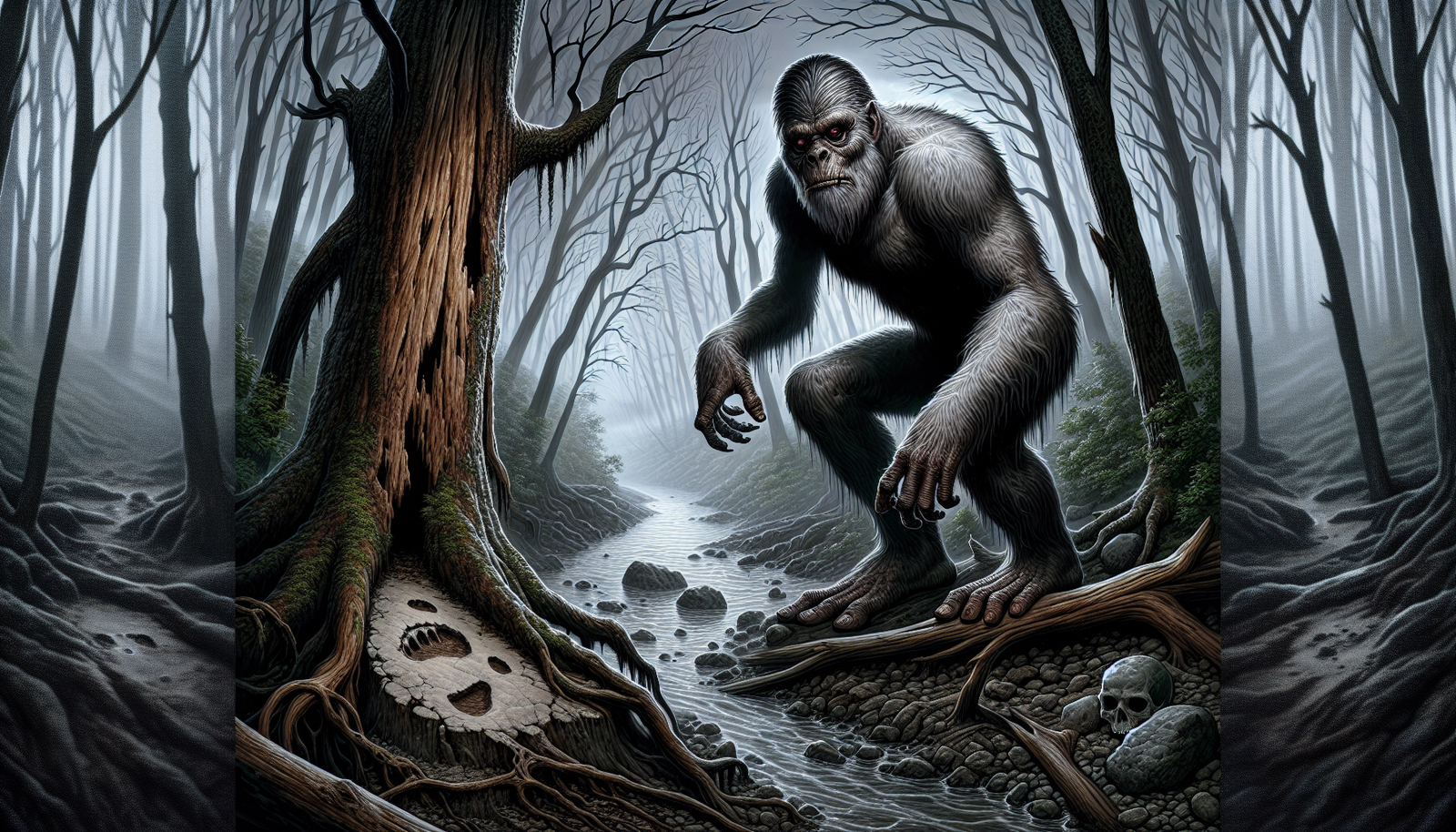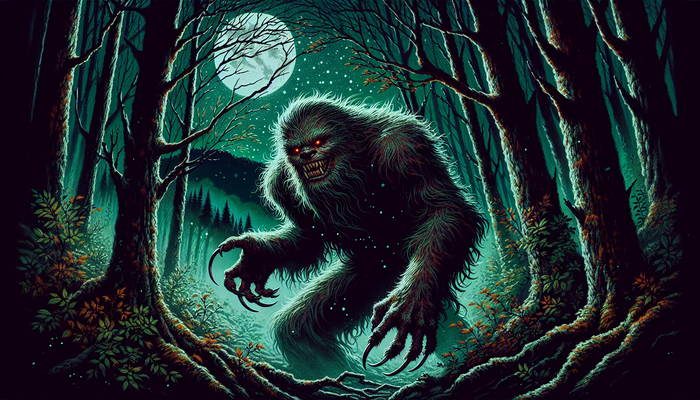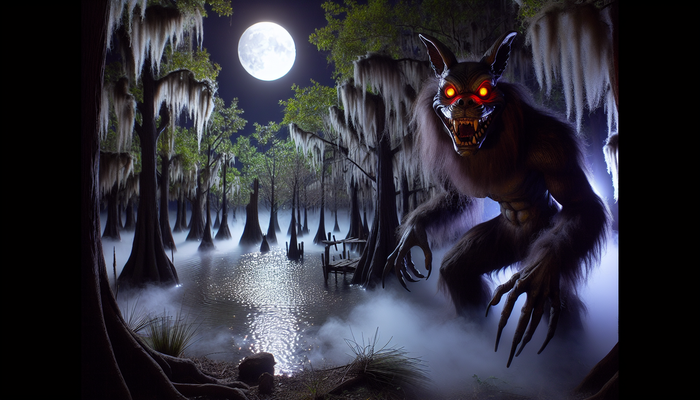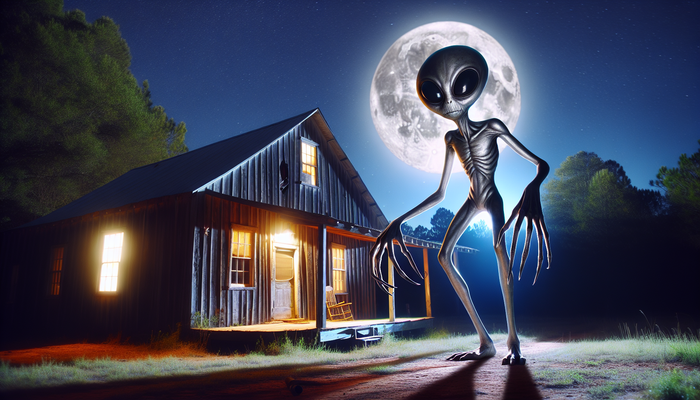Cryptid Creatures of Illinois: From Piasa to Enfield Horror

By Anthony Romano, Bigfoot Researcher and Engineer
The Land of Lincoln is known for many things - deep dish pizza, the Sears Tower, the Cubs, corrupt politicians. But few realize that Illinois is also a hotbed of cryptozoological activity, a veritable Midwestern mecca for mysterious creatures that lurk at the shadowy edges of reality. For centuries, this unassuming prairie state has been home to a menagerie of mythical beasts, from giant birds to mud monsters to wolfmen. As a cryptid researcher and tech enthusiast, I've long been fascinated by the sheer diversity and tenacity of Illinois' phantom creatures. Join me as we journey into the dark heart of cryptid country and explore some of the most compelling and strangest creatures ever to haunt the heartland.
The Piasa: The Bird That Devours Men
Our story begins way back in 1673, when French explorers Jacques Marquette and Louis Jolliet were making their way down the Mississippi River. As they passed the towering bluffs near what is now Alton, Illinois, they came across a massive painting on the rock face that chilled them to their core. It depicted a fearsome dragon-like creature with horns, scales, and a long beard. The beast had the body of a serpent, the head of a man, and talons like an eagle. The local Illini tribe called it the "Piasa" which roughly translates to "the bird that devours men."
According to Native American legend, the Piasa was a bloodthirsty demon that would swoop down from the skies and snatch villagers, carrying them off to its cave to be eaten. For years, the people lived in terror of the creature, until a brave chief named Ouatoga decided to put an end to its reign of terror. Ouatoga and his warriors hid near the entrance to the Piasa's lair and when the beast flew out in search of its next meal, they ambushed it, slaying it with a volley of poisoned arrows.
Marquette was so unsettled by the painting of the Piasa that he wrote in his journal that "even the boldest savages dare not Long rest their eyes" upon it. Little did he know that the Piasa was just the beginning of Illinois' long legacy of run-ins with cryptid creatures. As we'll see, the bird that devours men was only the first of many monsters to haunt this unassuming Midwestern state.
The Big Muddy Monster: Murphysboro's Mud-Caked Menace
Fast forward 300 years to the summer of 1973. The sleepy town of Murphysboro, nestled along the banks of the Big Muddy River in southern Illinois, suddenly found itself at the center of a cryptozoological maelstrom. It all began on the night of June 25, when a young couple was parked by the river, enjoying some alone time. Suddenly, they heard a rustling in the bushes and caught a glimpse of a huge, white-furred creature emerging from the woods. The beast was around seven feet tall, with a foul, musky odor that reminded them of a skunk ape. Needless to say, the lovebirds hightailed it out of there, racing to the local police station to report their close encounter.
In the weeks that followed, more sightings poured in. A four-year-old boy claimed to have seen a "big white ghost" lurking in his backyard. A group of Murphysboro residents told police they saw a huge, ape-like creature covered in matted fur and mud prowling the riverbanks. A woman even claimed the beast had attacked her pet dog. As news of the sightings spread, monster hunters from all over the country descended on Murphysboro, determined to catch a glimpse of the creature that had come to be known as the "Big Muddy Monster."
One of those intrepid researchers was none other than Loren Coleman, the famed cryptozoologist and author of such books as "Mysterious America" and "Cryptozoology A to Z." Coleman set up camp in Murphysboro and spent weeks interviewing witnesses, making casts of the creature's three-toed footprints, and even examining damage to a house that the monster had allegedly attacked. He heard strange, screeching cries echoing through the woods at night and collected dozens of reports of sightings. But despite his best efforts, Coleman never managed to catch a clear glimpse of the Big Muddy Monster itself.
So what was this mysterious creature that had the people of Murphysboro so spooked? Theories abounded. Some speculated that it was a large ape, perhaps an orangutan or chimpanzee, that had escaped from a traveling circus or zoo. Others wondered if it might be an unknown species of primate, a relic hominid that had somehow survived in the remote woods of southern Illinois. And of course, there were the inevitable cries of "hoax!" from skeptics who believed the whole thing was nothing more than a case of mass hysteria fueled by over-active imaginations.
Whatever the truth behind the Big Muddy Monster, the creature vanished back into the depths of the river bottoms as suddenly as it had appeared. In the years since, there have been sporadic sightings here and there, but nothing approaching the concentrated flap of encounters that gripped Murphysboro back in the summer of '73. Did the monster move on in search of new hunting grounds? Did it ever really exist at all outside of the fevered imaginations of those who claimed to have seen it? We may never know for sure. But one thing is certain - for a few brief, shining moments, Murphysboro was the cryptid capital of America, and the Big Muddy Monster was its reigning king.
The Enfield Horror: A Three-Legged Terror
That same summer of 1973, while Murphysboro was grappling with the Big Muddy Monster, another small Illinois town found itself in the grip of a very different kind of cryptid encounter. The people of Enfield, located about 100 miles to the east of Murphysboro, had their own close encounter with a creature that was so bizarre, so utterly alien, that it almost defies description.
It all started on the night of April 25, when a young boy named Greg Garrett was playing in his backyard. Suddenly, he caught a glimpse of a creature that he would later describe as being about four and a half feet tall, with gray skin, short claws, and glowing pink eyes. Oh, and it had three legs. Yes, you read that right - three legs.
The creature attacked Greg, tearing his shirt, before the boy was able to flee back into his house. But the weirdness was just beginning. Later that same night, the Garretts' neighbor, a man named Henry McDaniel, had his own run-in with the beast. McDaniel told police that he heard a scratching sound at his front door and when he went to investigate, he saw the creature standing on his porch. He described it as having a "short body, two little short arms coming out of its breast area and two pink eyes as big as flashlights."
McDaniel did what any red-blooded American man would do when confronted with a three-legged monster on his porch - he went and got his gun. He fired several shots at the creature, which let out a hissing sound "like a wildcat" before fleeing off into the night in a series of gigantic leaps. McDaniel claimed that the beast cleared 50 feet in just three bounds.
In the days that followed, more sightings were reported around Enfield. Investigators discovered bizarre footprints in McDaniel's yard, with six toe pads instead of the usual five. A local radio station even claimed to have recorded the creature's eerie, screeching cries. The town was soon overrun with curiosity seekers and monster hunters, all eager to catch a glimpse of the beast that had come to be known as the "Enfield Horror."
Theories about what the creature might be ranged from the plausible to the downright bizarre. Some speculated that it was a deformed kangaroo that had escaped from a zoo or circus. Others wondered if it might be a previously unknown species of primate or marsupial. And then there were those who claimed that the Enfield Horror was an alien creature, brought to Earth by UFOs that had been spotted in the area around the same time.
In the end, the Enfield Horror vanished just as suddenly and mysteriously as it had appeared. Like many of Illinois' most famous cryptid creatures, it left behind more questions than answers. What was this strange beast with its three legs and glowing pink eyes? Was it a flesh-and-blood creature unknown to science? An extraterrestrial visitor from beyond the stars? Or was it all just a case of misidentification and mass hysteria?
We may never know for sure. But one thing is certain - the Enfield Horror remains one of the most bizarre and baffling cryptid encounters ever reported in Illinois, or anywhere else for that matter. It's a reminder that sometimes, the creatures that haunt our imaginations and stalk the edges of our reality are stranger than anything we could possibly dream up on our own.
Thunderbirds: Giant Birds of Prey or Prehistoric Survivors?
When most people think of cryptid creatures, they tend to think of beasts that walk on four legs (or three, in the case of the Enfield Horror). But Illinois has also been home to a fair number of flying cryptids over the years, most notably the elusive and awe-inspiring Thunderbirds.
The legend of the Thunderbird has deep roots in Native American mythology, with many tribes across North America telling stories of gigantic birds with wingspans that could blot out the sun. These creatures were often associated with storms and lightning, hence their name. But while most people assume that Thunderbirds are purely mythical, there have been a surprising number of sightings of giant birds in Illinois over the years that suggest there might be more to the legend than meets the eye.
One of the most famous Thunderbird encounters in Illinois history occurred in the town of Lawndale on July 25, 1977. On that day, a 10-year-old boy named Marlon Lowe was playing outside with his friends when he was suddenly attacked by two enormous birds. The creatures swooped down out of the sky and grabbed Marlon, carrying him about 30 or 40 feet before dropping him to the ground, tearing his shirt in the process.
Marlon's mother, Ruth, heard her son's screams and ran outside just in time to see the two birds flying away. She described them as being "like condors" but with wingspans of 8 to 12 feet. Other witnesses in the area also reported seeing the giant birds around the same time.
The Lawndale incident is just one of many Thunderbird sightings that have been reported in Illinois over the years. In the town of Alton, near the confluence of the Mississippi and Illinois Rivers, there have been stories of giant birds dating back centuries. Some researchers have even suggested that the legendary Piasa bird, depicted in the famous rock painting that so terrified Marquette and Jolliet, may have been a Thunderbird.
In more recent years, there have been sporadic sightings of enormous birds soaring over the skies of Illinois, from the suburbs of Chicago to the remote forests of the Shawnee National Forest in the southern part of the state. These creatures are often described as being similar to condors or vultures, but much larger, with wingspans that can reach up to 20 feet or more.
So what are these giant birds that have been haunting the skies of Illinois for so long? Are they simply large specimens of known species, like the California condor or the turkey vulture? Or could they be something else entirely - perhaps surviving relics of a prehistoric species thought to have gone extinct long ago?
Some cryptozoologists have suggested that the Thunderbirds of Illinois and elsewhere may be living teratorns - giant predatory birds that once soared over North and South America during the Pleistocene epoch. Teratorns had wingspans of up to 24 feet and weighed as much as 180 pounds. They would have been an awe-inspiring sight to behold, and it's not hard to imagine how they could have inspired the Thunderbird legends of Native American folklore.
Of course, the idea that a species of giant bird could have survived undetected for thousands of years is a tough pill for many scientists to swallow. But cryptozoologists point out that new species are being discovered all the time, and that the remote wilderness areas of North America could easily hide a small population of teratorns or some other large avian species.
Whether the Thunderbirds of Illinois are flesh-and-blood creatures or simply the stuff of legend, they continue to capture the imaginations of those who look to the skies and wonder what might be soaring overhead. For centuries, these giant birds have been a part of the state's rich tapestry of folklore and mythology, and they show no signs of fading away anytime soon.
The Wolfman of Chestnut Mountain: Werewolf of the Prairie State
Moving from the skies to the forests, we come to one of Illinois' most intriguing and elusive cryptid creatures - the Wolfman of Chestnut Mountain. This werewolf-like beast was first spotted near the town of Galena in the early 2000s, and it has been popping up in scattered sightings ever since.
The first known encounter with the Wolfman occurred in 2010, when a vacationing psychologist from Chicago was driving along a remote road near Chestnut Mountain with her fiancé. Suddenly, they caught a glimpse of a huge, dark figure running across the road in front of their car. At first, they thought it was a bear, but as they got closer, they realized that this was no ordinary animal.
The creature was described as being over five feet tall and covered in shaggy, dark fur. But what really set it apart was the fact that it was running on two legs, like a human. The couple watched in amazement as the beast bounded off into the woods, moving with an agility and speed that was almost supernatural.
In the years since that initial sighting, there have been a handful of other encounters with the Wolfman of Chestnut Mountain. Witnesses describe seeing a large, wolf-like creature with glowing red eyes and a distinctly humanoid shape. Some have even claimed that the beast has attacked their vehicles, leaving deep scratches in the metal.
So what is this mysterious creature that stalks the forests of northwestern Illinois? Is it a werewolf, straight out of the pages of a Hollywood movie script? A previously unknown species of canine, perhaps a surviving dire wolf or some other prehistoric predator? Or is it something else entirely, a creature that defies explanation and classification?
Cryptozoologists who have studied the Wolfman of Chestnut Mountain case point out that there have been similar sightings of upright, wolf-like creatures all over the Midwest, from the Beast of Bray Road in Wisconsin to the Michigan Dogman. Some researchers believe that these creatures may be part of a larger phenomenon of "cryptid canines" that have been spotted all over the world.
One theory is that these creatures may be some sort of surviving prehistoric species, perhaps a type of dire wolf or even a Neanderthal-like hominid that has managed to avoid detection by mainstream science. Others speculate that they could be the result of some sort of genetic experiment or mutation, perhaps related to the infamous "Montauk Monster" that washed up on a New York beach in 2008.
From Bigfoot to UFOs: Hangar 1 Publishing Has You Covered!
Explore Untold Stories: Venture into the world of UFOs, cryptids, Bigfoot, and beyond. Every story is a journey into the extraordinary.
Immersive Book Technology: Experience real videos, sights, and sounds within our books. Its not just reading; its an adventure.



























